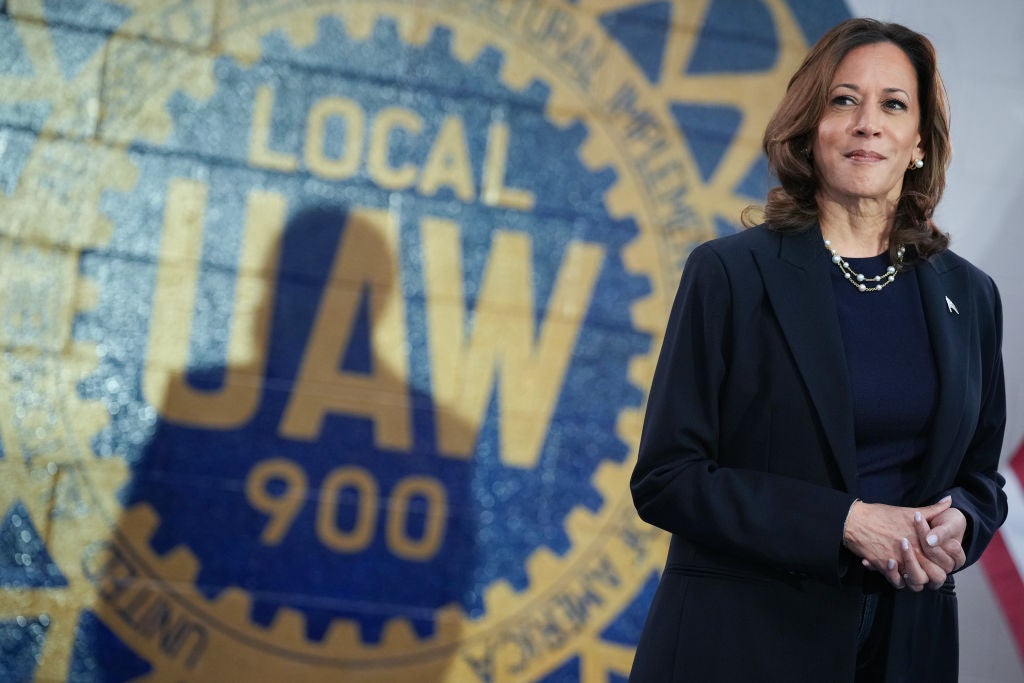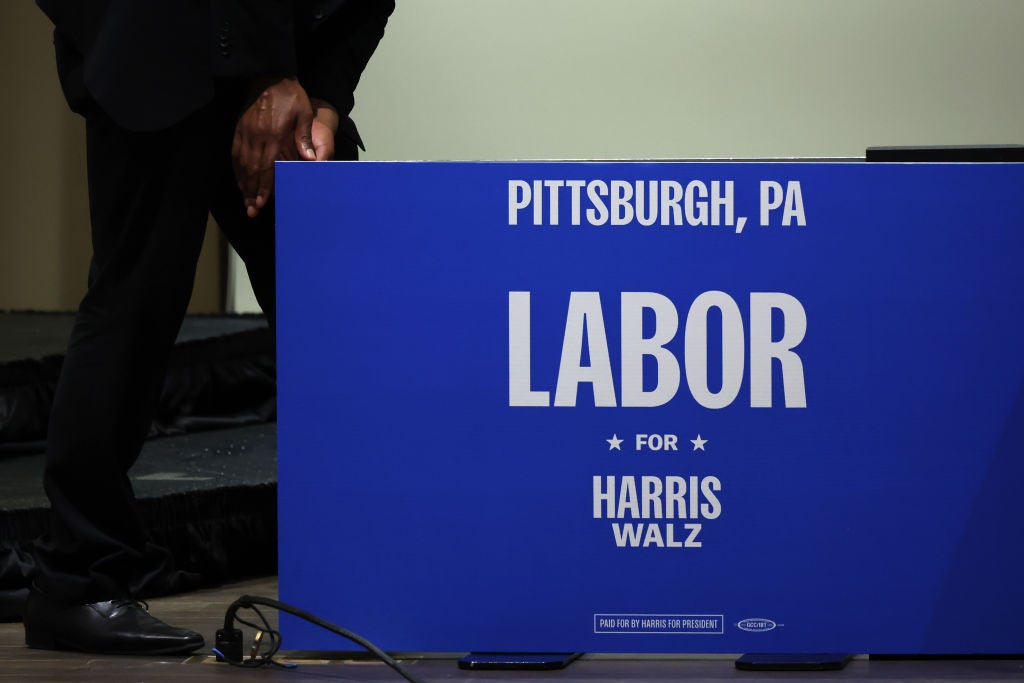Vice President Kamala Harris is charging towards election day in full turnout mode, delivering her “closing argument” in a massive rally on the Ellipse while making last-ditch appeals in key battleground states.
As she heads to Reno, Nevada on Thursday for what is likely to be her last visit to the state as a candidate, the vice president’s campaign is leaning hard on support from organized labor in the Rust Belt to shore up her strength there.
Harris and her opponent, Donald Trump, are focused on roughly a half-dozen states as the election enters its final hours. The former president has largely ended his overtures to organized labor, following the speech from Teamsters president Sean O’Brien at the Republican National Committee; the populist branding did not last until election day, in part tarnished by Trump’s own admission that he avoided paying workers overtime. The result? A new poll indicating that Harris leads Trump by a sizable margin among union households — even white, non-college-educated voters, a demographic which typically trends Republican.
Joe Biden, by comparison, is staunchly pro-union. Harris, who took over the Democratic ticket in July, is running identical to him on this issue — though some question if she will continue to allow labor-favorite Lina Khan to continue on at the Federal Trade Commission (FTC).
On Tuesday, Harris-endorsing UAW president Shaun Fain went on Facebook Live and took questions from union members — the address was aimed at members still “on the fence” or considering sitting out the election altogether. As part of UAW’s more assertive bent in the past few years — the union has ramped up strikes and other collective bargaining at major automakers — Fain said that it was vital to UAW’s survival to “elect politicians who will stand with us in those fights”, referencing Biden’s stand with union members on a picket line last year.
Chapters of Fain’s union are working to boost Harris’s numbers across Michigan, a crucial part of the “blue wall” which Hillary Clinton lost in 2016 but Joe Biden won back from Trump in 2020. A statement from UAW said that union members had door-knocked at 175,000 union homes in the last three weeks alone, noting a nearly 30-point advantage for Harris among households contacted by union canvassers.

And other unions are bolstering Harris’s campaign across battlegrounds, too. A group of four major unions, AFL-CIO, AFT, SEIU and NEA have teamed up on a joint voter-outreach operation targeting voters in Michigan, Georgia, Wisconsin and Pennsylvania, Arizona, Nevada and North Carolina. AFT, which has launched a nationwide bus tour as part of the effort, has held 110 events in dozens of cities in the past two months.
“We will be getting out the vote, uplifting issues and shining a spotlight on the choice between those who support working people, retirees and our children and communities, and those who want to return to a dark, divisive and grievance-filled past,” AFT’s Randi Weingarten said in September. “Between now and Election Day, we’ll make sure that our members are mobilized and our voices are heard.”
Michigan, Pennsylvania, and Wisconsin are top targets for the effort — all part of the “blue wall”, and also areas of high union membership. Polls of all three states have shown clear momentum in Harris’s direction in the final weeks of the race, though a Quinnipiac poll released on Wednesday showed Harris still behind the former president in Pennsylvania, albeit by a much smaller margin than weeks prior. It was a reversal, however, of one recent survey from the same pollster showing her up two points in the state in early October.
For unions, the fight for Pennsylvania means battling Trump’s support in the suburbs and rural areas of the state while simultaneously driving turnout as high as possible in deep-blue Philadelphia, Harrisburg and Pittsburgh. Unions like AFSCME and Unite Here! are wellsprings of volunteers for Democrats in the latter regard; both are actively canvassing in Philadelphia this week.
The Independent spoke to one retired AFSCME member volunteering with the union’s voter outreach efforts in the city on Wednesday. She explained why the union remains so successful at convincing current and former members to turn out to vote: by reinforcing the value of a union job (and a union pension!), and the kind of social safety net that it creates. Voters still largely understand, she said, that Republicans oppose legislation to expand collective bargaining rights.
“We’ve got to continue to be able to organize and tell people, ‘look at Project 2025. One of the things they have on there is, [Trump] wants to get rid of public service unions,” said Vanessa Fields. “And so, listen, guys, you want your union. Because you want those rights while you’re working, but you want that freedom when you retire [too].To live with…dignity.”
She summed up a senior’s argument in one sentence: “I don’t want to go do my grocery shopping at the Dollar Store.”

Gwen Mills, Unite Here!’s president, wrote in a letter posted to the website of AFL-CIO on Wednesday: “We could spend a lot of time trying to read the tea leaves on races that are within the margin of error. Or instead of being anxious, we can instead focus our energy on the margin of effort. My union, UNITE HERE, is choosing the latter.”
She added that her union will reach “3.5 million doors in ten key battlegrounds” by next Tuesday.
Fields, who says her role involves giving/getting feedback from those she jokingly called the “kids” out canvassing, said those arguments were hitting home for union members and others. But the real issue she hears about, Fields stressed, was the threat to democracy which Democrats and many other Americans fear Trump poses.
“What I’m hearing is freedom is on the line. Democracy is on the line, especially for Black folks,” said Fields, who herself is Black. “When we talk about, ‘we’re not going back,’ we’re talking about Black folk not going back to the 1950s when, you know, you had colored entrances to go into places, water fountains, segregated schools, the whole nine yards.”






